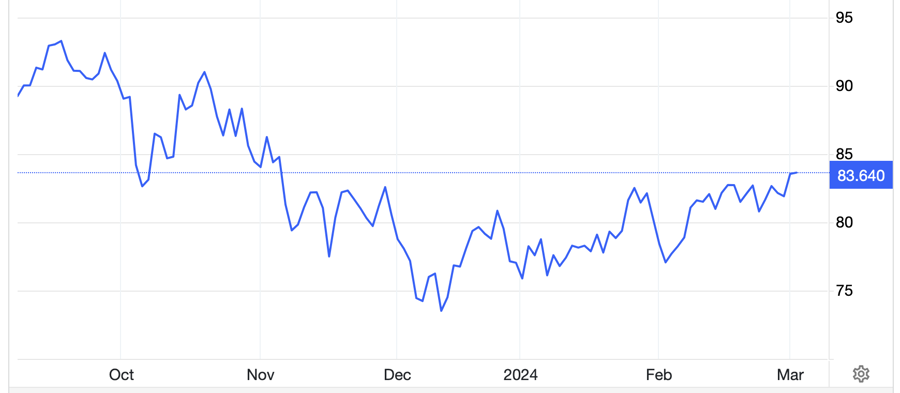OPEC+ is the alliance between the Organization of the Petroleum Exporting Countries (OPEC) and its allied countries, including Russia. The unofficial leaders of the alliance are Saudi Arabia and Russia.
Saudi Arabia’s state news agency, SPA, reported on March 3 that the country will extend the voluntary crude oil production cuts by 1 million barrels per day until the end of the second quarter. The statement said that Saudi Arabia’s crude oil production will hover around 9 million barrels per day until the end of June.
As for Russia, the state news agency Tass reported that Deputy Prime Minister Alexander Novak stated that the country will cut its crude oil production and total crude oil exports by a combined 471,000 barrels per day until the end of June. In the first quarter, Russia voluntarily reduced its oil supply by 500,000 barrels per day, which is more than its commitment for the second quarter.
The key producers within OPEC, Iraq and the United Arab Emirates (UAE), have also extended their voluntary production cuts until the end of the second quarter, with reductions of 220,000 barrels per day and 163,000 barrels per day respectively, according to Iraq’s state news agency INA and UAE’s WAM news agency.
In November last year, the OPEC+ countries decided to maintain the group’s official production cuts, amounting to a total reduction of 2 million barrels per day, until the end of 2024.
In addition to this program, some OPEC+ members, including Saudi Arabia and Russia, have voluntarily cut their oil production by a total of 2.2 million barrels per day until the end of the first quarter of 2024. This plan has now been extended until the end of the second quarter.
The decision to extend the production cuts demonstrates OPEC+’s determination to push up oil prices, even if it means losing market share to other oil suppliers, particularly U.S. shale oil producers.
The latest production cut announcement by OPEC+ comes as global oil prices have been relatively stagnant, ranging from $75 to $85 per barrel since the beginning of the year, despite OPEC+’s tightening supply, persistent attacks by Houthi rebels on the vital Red Sea shipping route, and the escalating conflict in the Gaza Strip between Israel and Hamas – the Palestinian rebel group backed by Iran.

The downward pressure on oil prices at this time primarily stems from the bleak outlook for the Chinese economy, the world’s largest crude oil importer. The pressure could intensify in the coming months as Chinese refineries enter their annual maintenance period, with the peak scheduled for the second quarter, leading to a decrease in crude oil demand.
Unlike official production policy changes, voluntary production cuts within OPEC+ do not require unanimous agreement from all alliance members at an official meeting, nor do they require an allocation of production changes among the members.
Typically, OPEC+ countries do not dispute voluntary production adjustments as long as they are consistent with the spirit of the existing policy. The voluntary production cuts pursued by some members are complementary to OPEC+’s existing official production cuts.
Further discussions on OPEC+’s production policy will take place in June. At that time, independent third-party data providers will complete assessments of the baseline production levels of the alliance’s member countries – the basis for determining each country’s production quota. A higher baseline will lead to higher production limits, allowing the respective oil-producing countries to generate higher revenues from oil extraction and sales, especially in a high oil price environment.
In a surprising move, Saudi Aramco – the giant state-owned oil company of Saudi Arabia – announced in late January that it would suspend its long-term plan to increase crude oil production capacity from 12 million barrels per day to 13 million barrels per day by 2027. Saudi Arabia’s Minister of Energy, Prince Abdulaziz bin Salman, later explained that this decision was driven by the Gulf powerhouse’s green transformation process.
Global oil prices edged up after the announcement of OPEC+’s extension of voluntary production cuts. At around 9 a.m. Vietnam time on March 4, Brent crude oil fluctuated above $80 per barrel in London, while WTI crude oil reached nearly $84 per barrel in New York.
Analysts believe that the expectation for OPEC+ to maintain voluntary production cuts has already been fully reflected in oil prices. Last week, Brent crude oil prices rose by about 2.4% and WTI crude oil prices rose by 4.5%.
Therefore, in the short term, oil prices will be more influenced by economic news from China and geopolitical developments in the Middle East.
China kicked off its annual National People’s Congress on March 4, amid global investor expectations that Beijing will announce new stimulus measures to revive its struggling economy due to the prolonged real estate crisis and weak consumer demand. If China introduces more aggressive economic stimulus measures at this session, oil prices will find new momentum.












